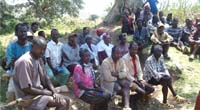

A breakdown can occur at any point in the communication process. Barriers (obstacles) can inhibit communication, resulting in misunderstanding or distortion of the message. This can lead to conflicts of views and the inability to make effective decisions. Barriers can also prevent the achievement of the project or programme goals.
Generally communication barriers can be categorised as follows:
Remember that you cannot necessarily avoid or overcome all these barriers, but should try to find ways of minimising them.
List some of the barriers to effective communication that you have encountered in your health education activities, whether as a health professional or a recipient of health education.
You may have come across many different barriers to health education work, including several of the ones discussed in this study session. Some situations involve several barriers — for example, if someone is in a room that is noisy (environmental) and their hearing isn't very good (physical), and because they are low status (cultural) they have been put at the back, this will all make it much harder for them to understand the messages being delivered.
To overcome communication barriers:

Even if all the barriers have been removed, communication could still be a failure without good presentation. Good presentation requires a firm understanding of the subject and establishing a positive relationship with the audience as well as choosing the right channels or media.